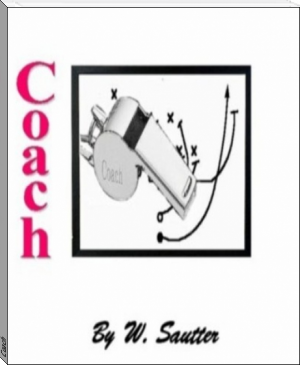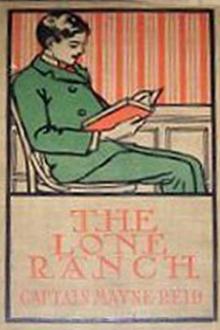The Young Voyageurs: Boy Hunters in the North, Mayne Reid [some good books to read .txt] 📗

- Author: Mayne Reid
Book online «The Young Voyageurs: Boy Hunters in the North, Mayne Reid [some good books to read .txt] 📗». Author Mayne Reid
“A better explanation may be this: The north and the cold zones are the natural habitat of most migratory birds. It is there that they bring forth their young, and there they are at home. In tropical regions they are only sojourners for a season, forced thither, some of them, by a cold which they do not relish; but others, such as the water-fowl, by the frost, which, binding up the lakes, rivers, and swamps, hinders them from procuring their food. They are thus compelled to make an annual migration to the open waters of the South, but as soon as the ice has given way before the genial breath of spring, they all return rejoicing to their favourite home in the North, when their season of love commences.
“The ‘hoopers’ follow this general law, and migrate to the northward every spring. They breed upon islets in the numerous lakes that stud the whole northern part of the American continent. Eminences in swamps are also chosen for breeding places, and the ends of promontories that jut out into the water. The spot selected is always such that the swan, when seated upon her nest, can have a view of the surrounding country, and detect any enemy long before it can approach her. The top of the dome-shaped dwellings of the musk-rat, or musquash (Fibre zibethicus), is often selected by the swan for her nest. These curious little houses are usually in the midst of impenetrable swamps: they are only occupied by their builders during the winter; and as they are deserted by them in early spring, they are therefore quite at the service of the swan for the ‘balance of the season.’ The bird makes a large cavity in the top, and lines it with such reeds and grass as may be found near the spot.
“The hooper lays from six to eight eggs, and sits upon them for a period of six weeks, when the cygnets come forth covered with a thick down of a bluish-grey colour. While sitting upon her eggs, the swan is exceedingly watchful and shy. She ‘faces’ towards the point whence she most apprehends danger. When the weather is severe, and the wind cold and keen, she changes into that position which is most comfortable. If her nest be upon a promontory instead of an island, she usually sits with her head to the land, as she feels secure that no enemy will reach her from the waterside. From the land she has not only man to ‘look out’ for, but the wolverene (Gulo luscus), the lynx (Felis Canadensis), foxes, and wolves.
“The Indians often snare the swan upon her nest. Of course the snare—a running noose made from the intestines of the deer—is set in her absence. It is placed upon the side by which she enters, as these birds enter and leave the nest upon opposite sides. The snare must be arranged with great care, and with clean hands; and the Indians always take the precaution to wash their hands before setting it, else the swans, whose sense of smell is very acute, will perceive the presence of danger, and will not only keep away for a time, but sometimes desert the eggs altogether. There are many other birds that have a similar habit.
“So much for the ‘hooper,’” continued Lucien; “now for the ‘trumpeter.’ This is the largest of the American swans, being found to measure seventy inches in length. Its specific name ‘trumpeter’ (Cygnus buccinator) is given to it on account of its note, which resembles the sound of a French horn, or trumpet, played at a distance. The bird is white, with black bill and feet, and has also a reddish orange or copper tinge upon the crown and neck; but it wants the yellow spot between the split of the mandibles and the eye. It is easily distinguished from the hooper, both by its louder note and larger body. Its habits, however, are very similar, except that it seems to be more gregarious,—small flocks of six or eight often appearing together, while the hooper is seen only in pairs, and sometimes solitary. Another distinction is, that the trumpeter arrives much earlier in its migrations to the North, being the earliest bird that appears except the eagles. It breeds as far South as latitude 61 degrees, but most generally within the Arctic circle. Its nest is constructed similarly to those of the hooper, but its eggs are much larger, one of them being a meal for a moderate eater, without bread or any other addition. The trumpeter frequently arrives in the North before the lakes or rivers are thawed. It is then obliged to find sustenance at the rapids and waterfalls, where the Indians can approach under cover, and many are shot at such times by these people. At all other times, as you, François, have observed, it is a bird most difficult of approach; and the Indian hunters only attempt it when they have a long-range gun loaded with ball.
“The third species of American swans is that known as Bewick’s swan (Cygnus Bewickii), called after the naturalist of that name. It is the smallest of the three, rarely measuring over fifty-two inches in length, and weighing only fourteen pounds, while the hooper is over twenty pounds in weight, and the trumpeter is often obtained of the enormous weight of thirty!
“Bewick’s swan is also said to be identical with one of Brehm’s singing swans. Its colour is almost similar to that of the hooper, and the two are often mistaken for each other. The size and the tail-feathers of all three of the American swans form a sufficiently specific distinction. In the trumpeter these are twenty-four in number, in the hooper twenty, while the small species has only eighteen.
“Of the three, the last-mentioned is the latest on its annual journey, but it breeds farther North than either of the others. Its nest is found upon the islands of the Arctic Sea; it is usually built of peat-moss, and is of gigantic dimensions, being six feet long by five in width, and nearly two feet high. In the top of this pile is the nest itself, forming a large round cavity nearly two feet in diameter. The eggs are of a brownish white, with clouds of darker tint.
“I have remarked,” continued Lucien, “a singularity in the geographical distribution of these three species. Upon the Pacific coast the smallest kind and the hooper only are met with, and the small ones outnumber the others in the ratio of five to one. In the interior parts of the continent only the hoopers and trumpeters appear; and the trumpeters are by far the most numerous, while upon the eastern coasts of America the hoopers are the sort best known.
“The swans are eagerly hunted both by the Indians and white hunters. Their skins, with the quills and down, form a source of profit to the natives of the fur countries, who dispose of them to the Hudson’s Bay Company. In some years as many as ten thousand skins have been exported, and sold at the rate of six or seven shillings each. Most of the skins thus sold were those of the trumpeter swans, which are the most numerous.
“Now,” said Lucien, in conclusion, “you know as much about the swans as I do; so I shall drop the subject, and recommend to all of you a piece of roast swan, which is now just done to a turn, and which I doubt not will be found less dry than my lecture.”
A few days brought our travellers to the settlement of Red River, where they made but a very short stay; and, having procured a few articles which they stood in need of, they resumed their journey, and floated on towards Lake Winnipeg. The swans were seen in greater numbers than ever. They were not less shy however, and François, as before, in vain tried to get a shot at one. He was very desirous of bringing down one of these noble birds, partly because the taste he had had of their flesh had given him a liking for it; and partly because their shyness had greatly tantalised him. One is always more eager to kill shy game, both on account of the rarity of the thing, and the credit one gets for his expertness. But the voyageurs had now got within less than twenty miles of Lake Winnipeg, and François had not as yet shot a single swan. It was not at all likely the eagles would help him to another. So there would be no more roast swan for supper.
Norman, seeing how eager François was to shoot one of these birds, resolved to aid him by his advice.
“Cousin Frank,” said he, one evening as they floated along, “you wish very much to get a shot at the swans?”
“I do,” replied François,—“I do; and if you can tell me how to accomplish that business, I’ll make you a present of this knife.” Here François held up a very handsome clasp-knife that he carried in his pouch.
A knife in the fur countries is no insignificant affair. With a knife you may sometimes buy a horse, or a tent, or a whole carcass of beef, or, what is stranger still, a wife! To the hunter in these wild regions—perhaps a thousand miles from where knives are sold—such a thing is of very great value indeed; but the knife which François offered to his cousin was a particularly fine one, and the latter had once expressed a wish to become the owner of it. He was not slow, therefore, in accepting the conditions.
“Well,” rejoined he, “you must consent to travel a few miles by night, and I think I can promise you a shot at the trumpeters—perhaps several.”
“What say you, brothers?” asked François, appealing to Basil and Lucien; “shall we have the sport? Say yes.”
“Oh! I have no objection,” said Lucien.
“Nor I,” added Basil. “On the contrary, I should like it above all things. I wish very much to know what plan our cousin shall adopt. I never heard of any mode of approaching these birds.”
“Very well, then,” answered Norman, “I shall have the pleasure of instructing you in a way that is in use in these parts among the Indians, who hunt the swan for its skin and quills, which they trade to us at the post. We can manage it to-night, I think,” continued he, looking up at the sky: “there is no moon, and the sky is thick. Yes, it will be dark enough.”
“Is it necessary the night should be a dark one?” asked François.
“The darker the better,” replied Norman. “To-night, if I am not mistaken, will be as black as pitch. But we need to make some preparations. It is near sundown, and we shall have just time to get ready for the business. Let us get ashore, then, as quickly as possible.”
“Oh! certainly—let us land,” replied all three at once.
The canoe was now turned to the shore; and when it had arrived within a few feet of the land it was brought to a stop. Its keel was not allowed to touch the bottom of





Comments (0)